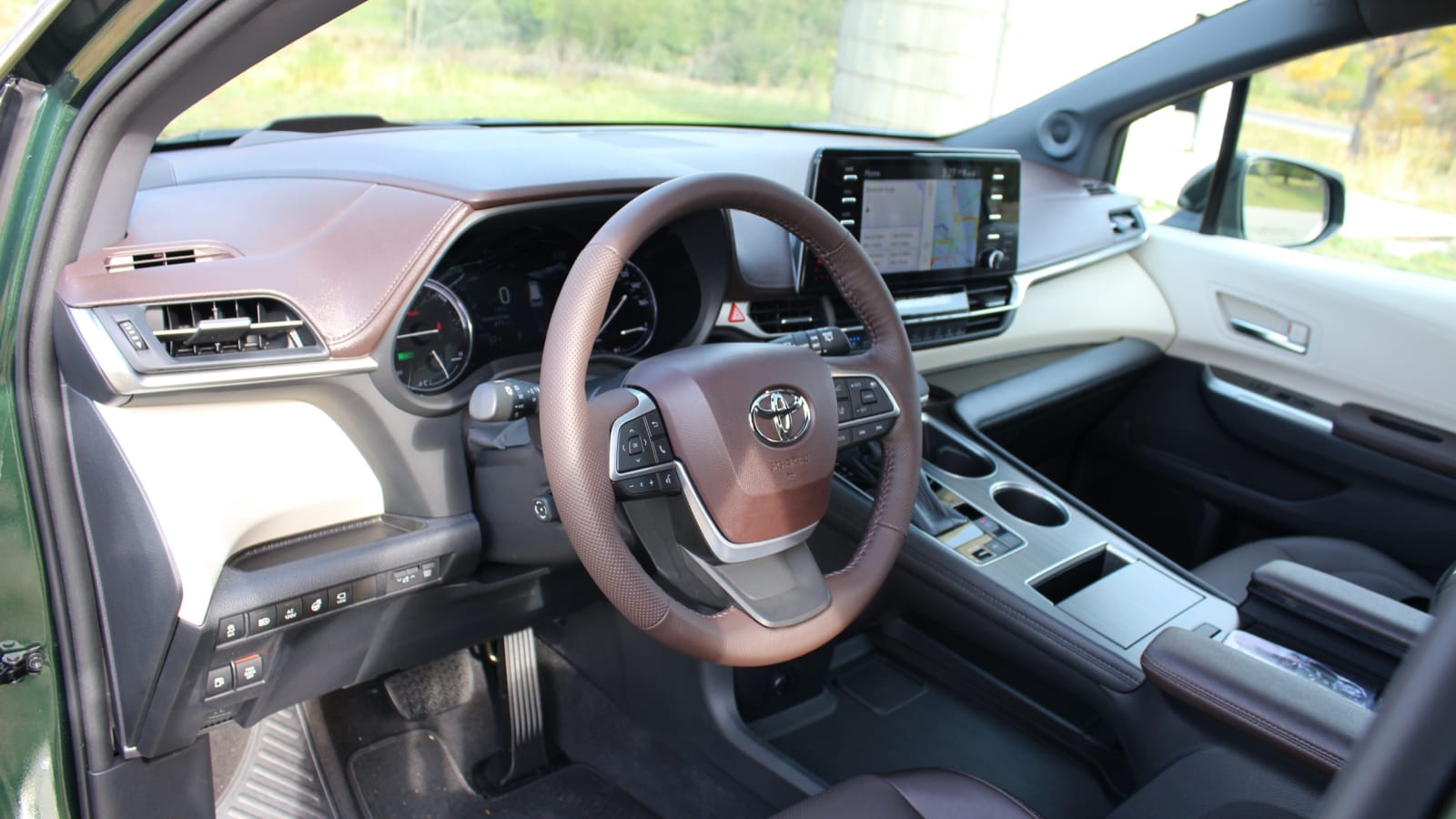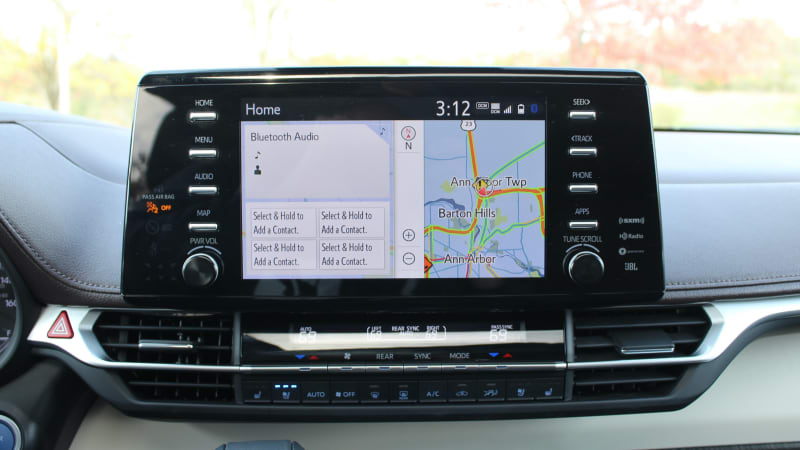ANN ARBOR, Mich. — The minivan segment isn’t a huge one, and it’s largely dominated by three players. There’s the stylish Chrysler Pacifica, with the excellent plug-in hybrid option. The Honda Odyssey unapologetically leans into its minivan-ness and family-hauling duties. Then there’s the new, totally redesigned 2021 Toyota Sienna. Its selling points are immediately apparent: unique styling, a standard hybrid powertrain and available all-wheel drive. Oh, and it’s a Toyota, which precedes itself with a reputation for reliability and utility, as well as a huge existing customer base. Barring some sort of dealbreaker in the test drive, this blend of existing traits (brand, AWD) and new ones (design, hybrid only) should probably be enough to make the Sienna appealing to those shopping in this lightly stocked aisle.
Spoiler alert: we found no dealbreakers during our test drive, but we were able to dig deeper into what we love, what we like and what we can accept.
First, we like the looks. Toyota did this van a service by making it look more like an SUV. Toyota’s not shy about gaping maws on its vehicles, but the prominent grille looks especially supportive of the high hood and thin, sweeping LED headlights. The character line that traces up and over the bulging rear fender gives a sense of fortitude below the rising beltline. Toward the rear is where the Sienna looks most like a minivan, where the long roof and vast liftgate can’t be downplayed by any design tricks. Still, the roof spoiler and slender LED taillights give this van the best possible rearward expression.

Inside, the Sienna makes a fantastic use of the available space, and includes a wealth of cubbies and pockets for stashing items of various sizes. The huge storage area below the center console “bridge” can accommodate a tote bag or large purse and, when empty, adds to the open airiness of the front seats. There are little nooks and crannies in the doors for beverages or other small items. Cupholders abound, including those on the sides of the second-row captain’s chairs that use little cargo nets to keep beverages in place. There’s a shelf just below the dash, which is where the wireless charging pad lives, but the two little nubs that are supposed to hold it in place are no match for even the most average of corners. Don’t leave your phone there if you don’t have a passenger to fetch it for you from wherever it lands (usually at their feet). Thankfully, there are plenty of other places to stash your phone within easy reach, like the slot in front of the center console cupholders.
The standard 9-inch touchscreen infotainment display is bordered by a number of physical buttons and knobs. It’s hard to beat the slick functionality of the Pacifica’s UConnect system, or the customizable menus in the Odyssey, but we didn’t have to deal with any of the major glitches or lagginess we’ve experienced in other Toyota infotainment systems. Below it, the climate control system gets its own display and set of controls. Our top-of-the-line Platinum tester came with heated and ventilated front seats, and heated second-row captain’s chairs are standard in this trim level. The ventilated seats made more noise than we’re used to, but that’s a small price to pay in exchange for comfort and a sweat-free shirt-back.
We absolutely love the Sienna’s “Super Long Slide” captain’s chairs in the second row. Although the Sienna’s second-row seats already slid further fore and aft than its competitors, Toyota lengthened their travel even further for 2021. “Super Long” amounts to 25 inches of travel, and is made possible by a seat redesign that lets the base partially slip past the rear wheel wells. Slid to the rear, they give occupants all the legroom they could’ve dreamed of, and make the optional ottoman leg rests possible (our tester sadly didn’t have them). They slide forward all the way to the front seats. A second lever folds the seat cushion up and the seatback forward to either provide an easy ingress into the third row, or to maximize cargo volume without removing the seats.
Now, they don’t slide left to right like the Honda Odyssey’s “Magic Slide” captain’s chairs, or fold into the floor like the non-hybrid Pacifica’s “Stow & Go” seats (the plug-in version’s seats can’t be stowed away but are more comfortable as a trade off). There are arguments for all systems, but Toyota’s seems to strike a fine balance of passenger comfort and cargo-focused utilitarianism. If anything, the added legroom they provide seems like it makes the Sienna’s seating setup especially good for families with older kids.
In the trunk, the Sienna boasts a deep load floor, similar to the competition. In addition to being able to hold a bulk of your belongings, it’s also where the rear seats fold into when you need to maximize cargo space. The handles used to fold the seats into the floor aren’t the tidiest in terms of looks, but they’re a solid grab point, and the motion of folding and unfolding the seats is smooth and fluid. When folded, it’s not the world’s flattest load floor, but it’s good enough for loading bulky cargo. Beware of small items, though, that could fall through the cracks. A final bonus, again, is the maneuverability of the second row, allowing you to make the most of the cargo area without removing the captain’s chairs.
There are several neat features available. One is an in-car vacuum, like that in the Honda Odyssey. The other is a small, built-in refrigerator unit behind the center console, easily accessible to the occupants of the second row (no other minivan offers this). A third feature that isn’t revolutionary but greatly appreciated is a pair 120-volt outlets — one for the second row, another in the cargo area. They support three-prong plugs, and are rated to 1500 watts, which can accommodate some high-energy appliances or tools. There’s a $200 digital rear-view mirror option in the top trim levels. The Sienna, like Pacifica, also offers a surround view parking camera, which is helpful navigating small parking lots with a big minivan. We also appreciated our tester’s color head-up-display, which helps keep eyes on the road.
Still, there are some features the competition has that the Sienna doesn’t. Sienna has a small sunroof over the front row, but there’s no panoramic sunroof option to bring in more light to the rear passengers. There’s a rear-seat entertainment option available, but passengers don’t get their own individual screens like they do in the Pacifica. Like the Honda Odyssey with CabinTalk, the Sienna offers Easy Speak to project your voice to the rear passengers, but there’s no overhead camera like Honda’s CabinWatch to keep a closer eye on kiddos (especially rear-facing ones).
Of course, the new Sienna can’t match the Pacifica’s plug-in hybrid option and its 32 miles of all-electric range. Still, the Sienna has its own novel feature lurking under the hood: a standard, traditional hybrid powertrain that grossly surpasses the fuel economy of its competitors’ standard V6 engines — the Pacifica’s included. Toyota estimates 36 mpg combined for two-wheel-drive Siennas, and 35 mpg combined with all-wheel drive. The front-drive, V6-powered Odyssey and Pacifica both get 22 mpg combined. That’s a difference that’ll save you hundreds of dollars on gas every year.

Again, this hybrid van has no plug. Even better, the 1.9-kilowatt-hour battery doesn’t cut into the cargo space at all, being housed beneath the front seats. Net output from the 2.5-liter four-cylinder and electric motors (two standard, three in the AWD) comes in at 245 horsepower. That’s down from the 296 horsepower of the previous generation’s V6 as well as the comparable outputs of those V6-powered competitors. It certainly won’t be the top choice for leadfooted minivan drivers, but that’s a minority, if possibly an oxymoron. For everyone else, the new model actually weighs less than before, slightly mitigating the power loss, while the instantaneous nature of the electric torque make it feel quick off the line. The only real drawback is living with the CVT. That’s something much of the modern commuting world has come to live with, but we did feel self-conscious about the droning with family in the car. It’s one of those things you get used to, tough.
Otherwise, the drive is smooth and mostly quiet. When not accelerating, the engine makes little sound. Noise from the wind and road are mostly filtered out before intruding into the cabin. The suspension is taut enough to provide good support for the Sienna’s long, bulky body, but not punishing over the craggy roads of southeast Michigan. Your author’s pregnant and car-sickness-prone wife had no complaints.
With no passengers aboard, we traveled some of the grubbier dirt roads in our area, where the Sienna felt similarly composed. We didn’t encounter any inclement weather to test the limits of the all-wheel drive, but we didn’t encounter any mid-corner instability on loose surfaces. Regardless, the “AWD” badge on the back will be a confidence booster to Sienna customers living within the Snow Belt, were four-wheel motivation can often be a requirement for certain buyers. As such, it’s a leg up on all but the Chrysler Pacifica, which also offers all-wheel drive.
The Sienna gets a suite of standard driving assist features called Toyota Safety Sense 2.0. This includes automatic emergency braking with pedestrian and cyclist detection, blind-spot monitoring, rear cross-traffic alert, lane departure warning with steering assist, lane keeping assist, auto high beams and road sign assist. Also included is a well-executed adaptive cruise control system. Following distances and speed changes are comfortable enough that we didn’t find the need to intervene often. The system can work with the steering to keep you centered in your lane on the highway, but it doesn’t trace the lanes well when the highway takes a sharper curve. Neither does the Odyssey’s, though, and the Pacifica lacks this feature entirely.






